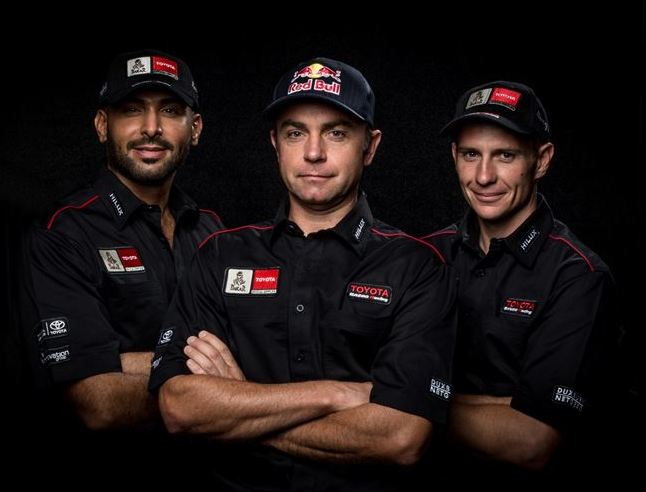Despite the threat of more heavy rain, Stage 2 of Dakar 2016 took place between Villa Carlos Paz and Termas de Río Hondo on January 4th in mostly sunny and hot conditions. The stage was shortened by 134 km to avoid a flooded section of the route, but even so it proved to be a stern test for the 110 cars that started the stage. Among them was Toyota Gazoo Racing SA’s Giniel de Villiers and Dirk von Zitzewitz (#301), who powered to a steady 4th place on the stage.
The drive of the day, however, belonged to teammates Leeroy Poulter and navigator Rob Howie, who started today’s stage in 23rd position after getting caught in a slower competitor’s dust on the prologue. Dakar’s rules see the top ten crews depart at three minute intervals, with the next ten cars pulling away two minutes apart. After that, the gap is down to one minute, which means that Poulter/Howie’s starting position placed them in the midst of slower competitors’ dust.
“They dug deep, however,” said a relieved Team Principal, Glyn Hall, from the bivouac at Termas de Río Hondo, “and overtook a number of slower teams to post a really good stage time. As a result, they’ll be starting in sixth place tomorrow.”
For Yazeed al Rajhi and navigator Timo Gottschalk, in the third Toyota Gazoo Racing SA Hilux, Stage 2 was a more frustrating affair. The pair started the day in 20th position, and even though they improved significantly on that, they were left pondering what could have been had they not caught up with the slower crews ahead of them early in the stage.
For former winner Nani Roma (MINI) and his teammate Orlando Terranova, today’s stage will be one to forget. Both crews lost significant time in the water and mud, but managed to complete the stage. Carlos Sainz (Peugeot) also lost time in the stage, coming through more than 11 minutes behind the stage winner. De Villiers and navigator Dirk von Zitzewitz nearly fell foul to the same deep, muddy section, but a quick-witted De Villiers decided to send his vehicle up a bank to the side, and negotiate a dry, open field instead. Their time loss at the mud section was thus restricted, helping the consistent pair to maintain a position at the head of the field.
The stage was won by former multiple WRC champion Sebastien Loeb and navigator Daniel Elena (Peugeot), with teammate Stephane Peterhansel in second. Russia’s Vladimir Vasilyev (Toyota Hilux) posted the third-fastest time of the day, 02:28 behind the leader. De Villiers’ time was 03:31 slower than that of Loeb, but good enough for fourth place.
Though it is still early days, with only the prologue and Stage 2 to contribute to the standings, Loeb currently leads the race, with Peterhansel in second and Vasilyev in third. A total of five Toyota Hilux vehicles currently feature in the top ten.
“Giniel looked like he was one for a podium finish, with just 40 km to go,” explained Hall. “However, we had a number of warning lights come on on the dash, and he elected to be cautious to the end. We’ll change some parameters tonight, as the warnings weren’t serious.”
Other South African crews also made their mark on the race during Stage 2, with quad racer Brian Baragwanath posting the second-fastest time of the day. In the car category, Sean Reitz (Nissan) and Colin Matthews (Century) finally made their Dakar debut, as the prologue was stopped before they started on January 2nd.
The next stage will see the Dakar armada move from Termas do Río Hondo to the Argentine town of Jujuy. The start of the stage is on the southern tip of this route, and features undulating terrain with rally-style tight corners, which may require even more gear shifts than the 1,522 executed by De Villiers while negotiating Stage 2. The stage itself is 314 km in length, with an additional open section of 349 km to negotiate after the finish.
A total of 11 stages await competitors, as the Dakar continues northward to Bolivia, before returning to Argentina. The 2016 race ends on January 16th, in the Argentine city of Rosario.
